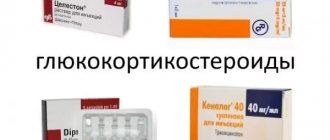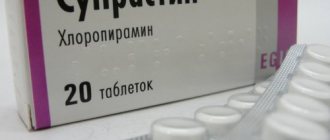Dosage forms and composition of Tramadol
The active component of the drug is Tramadol hydrochloride. This substance is an opioid agonist and acts on specific receptors in the central nervous system, inhibiting sensitivity to pain. Tramadol is considered an analgesic of mixed action. Available in several forms for local and systemic use:
- Tablets: white coated, scored, in dosages of 50, 100 mg. Packed in blisters, packaged in 10–100 pieces. Excipients in the composition: starch, silicon dioxide, magnesium stearate, MCC.
- Gelatin capsules: 50 mg each, yellowish in color, contain white powder inside the shell.
- Suspension for oral administration: clear sweetish liquid with mint and anise aroma, 1 ml - 100 mg of active ingredient, water, propylene glycol, glycerin, sucrose, flavorings, essential oils. Available in glass bottles
- Solution for injection: with a dosage of 50 mg Tramadol hydrochloride per 1 ml. Water-based, in glass ampoules 1–5 ml.
- Rectal suppositories: fat-based, white torpedo-shaped, packaged in cell blisters. Each suppository contains 100 mg of active substance.
Tramadol Retard tablets are also available with a dosage of up to 200 mg, which have a longer lasting effect.
How long does it stay in the body?
The time it takes for Tramadol to be metabolized and eliminated from the body is different for all patients. On average, the process of processing the substance takes up to 3 days. Factors that influence the rate at which drugs are eliminated from the body include:
- weight;
- age;
- experience of use;
- metabolic capabilities of the liver and kidneys;
- amount of liquid drunk;
- amount of drug taken.
It is possible to detect traces of tramadol use even after 4-6 months, but such studies are very expensive, and not every laboratory has the necessary reagents. Therefore, immediately when the first suspicions appear, you need to conduct rapid tests and begin treatment for drug addiction.
Tramadol can be detected in urine within 3 days from the date of the last dose, in blood within 1-2 days. Residues of the active substance can be stored in the hair for up to 6 months. But you need to consider whether additional methods of cleansing the body have been carried out. If carried out, the residence time of the drug in biological fluids is reduced.
It is almost impossible to cheat drug tests. The only thing that allows you to get a false result is replacing the biological fluid that is submitted for analysis. The reliability of all methods is 99%, provided that the human factor is excluded during the study.
How does Tramadol work?
The active substance of the drug, penetrating into the blood, binds to opioid receptors of various types in the brain and spinal cord. As a result, the production of pain neurotransmitters is reduced and the conductivity of neurons is inhibited. The intensity of painful sensations decreases, among other things, due to the effect of Tramadol on the receptors of the digestive tract.
- The drug inhibits the functioning of both cerebral hemispheres;
- has a calming effect;
- inhibits the cough reflex;
- affects the respiratory center.
The effect of use develops after 15–20 minutes and lasts up to 6 hours, depending on the intensity of the pain syndrome. The most effective dosage form is an injection solution. With prolonged use, the analgesic effect of Tramadol decreases, and the body requires a greater concentration of it.
The drug is metabolized in the liver tissues, part of it is excreted unchanged by the kidneys. The half-life of Tramadol can last up to 2 days or more in case of cholecystitis, hepatitis, hepatosis and other liver pathologies. The effect of the drug on the body continues.
Tramadol addiction
Drug addiction to Tramadol is similar to addiction to other drugs. It forms rapidly and causes irreversible personal changes.
Drug addiction is accompanied by severe withdrawal symptoms during the period of sobriety: a person experiences an irresistible desire to use drugs, severe tremors, convulsions, headaches, nausea, sweating and other symptoms. The situation is complicated by psychological dependence, due to which drug addicts often return to using medication even after a thorough detoxification stage.
Overdose
The introduction of a lethal dose leads to serious consequences for the body. As a result of the effect on the central nervous system, depression of the respiratory center is observed, the heartbeat slows down, blood pressure decreases, and the patient falls into a coma. Failure to provide medical care leads to death.
Tramal poisoning: first aid
If you take a large dose of the drug, it is necessary to perform emergency gastric lavage. The patient needs to take several glasses of warm water and press on the root of the tongue. It is necessary to call an ambulance. Gastric lavage using the “restaurant” method is performed only by conscious patients.
Withdrawal from Tramadol
This medication provokes severe withdrawal symptoms. A person experiences the following sensations:
- Desire to use the drug;
- Nausea and vomiting;
- Disorders of the gastrointestinal tract;
- Profuse sweating;
- Tremor of the limbs;
- Convulsive attacks;
- Increase or decrease in blood pressure.
If withdrawal occurs, you must contact a specialist. High-quality and timely drug treatment is aimed at treating severe addiction and returning life to normal.
REMOVAL AT HOME
When is Tramadol indicated?
The drug is used to reduce and eliminate pain of various origins:
- for physical injuries: dislocations, fractures, soft tissue ruptures, severe burns;
- consequences of surgical interventions;
- when performing invasive painful diagnostic procedures;
- in the later stages of malignant oncological tumors;
- after myocardial infarction;
- with neurological manifestations.
Injection forms of the drug, tablets, capsules and suppositories are approved for adults and children over 14 years of age. Tramadol drops can be used in patients from 1 year of age.
How long do drug addicts live?
People who use only tramadol live from 5 to 10 years. But isolated tramadol addiction is very rare. Opiate analgesics are more often combined with other drugs such as amphetamine or cocaine. In such cases, the life expectancy of drug addicts is from 3 to 7 years.
If a person has chronic health problems with active drug use, life expectancy does not exceed 3 years. In addition, long-term use of Tramadol, for 1 year or more, leads to the formation of heart defects, which often cause death.
The main cause of death in tramadol addiction is drug overdose.
With the systematic use of narcotic analgesics, physical and mental dependence develops. It is the main cause of chronic poisoning with painkillers.
Taken from the book: Pharmacology, tenth edition by D.A. Kharkevich
In what cases is Tramadol prohibited?
The use of analgesics in all forms is excluded in case of individual intolerance to the active and auxiliary substances, alcohol abuse or poisoning, or dependence on psychoactive substances. Other contraindications:
- suicidal tendencies, severe clinical depression;
- renal and liver failure;
- undergoing treatment with certain psychotropic drugs;
- epilepsy that cannot be corrected with medications;
- first trimester of pregnancy.
In late pregnancy and lactation, Tramadol is prescribed in exceptional cases for individual indications.
Historical facts
The drug entered the pharmaceutical market in 1962 thanks to the German company. Dr. Kurt Flick was responsible for all studies on the effects of the drug.
Due to its pronounced analgesic effect, tramadol began to be prescribed more often than all other analgesics. But due to widespread use, cases of drug addiction began to be noted, and soon most countries banned the sale of the drug without a prescription. There are approximately 70 million prescriptions for Tramadol.
In Russia, Belarus, and Ukraine, Tramadol is sold only by prescription. In Asia and South Africa, the drug can be purchased at any pharmacy. This leads to massive pharmaceutical drug addiction.
In most European countries, Tramadol is used in combination with other drugs or to ease withdrawal after an amphetamine “marathon”, during heroin withdrawal, which is life-threatening, and even to relieve a hangover.
Side effects of Tramadol
While using the medication, dizziness, general lethargy, increased drowsiness, decreased appetite and nausea are possible. In rare cases, and after overdoses, the following develop:
- impaired coordination of movements;
- tachycardia;
- visual or auditory hallucinations;
- respiratory depression;
- vomiting, diarrhea;
- abdominal cramps;
- skin itching.
In case of intoxication with the drug, the following are possible: urinary retention, confusion or loss of consciousness, vascular collapse, convulsions. In women, long-term use may cause menstrual irregularities. It is typical that prolonged use of the drug leads to drug dependence.
Analogs
Tramadol is produced by more than 15 pharmaceutical companies around the world. Therefore, the trade names of drugs with the active ingredient tramadol are different. For example, German companies more often use the name “Tramadol retard”. There are names such as “Tramadol Avexima” or “Tramaclosidol”.
Analogues of the drug are all narcotic analgesics belonging to the group of opioid receptor agonists. Such drugs include:
- Methadone;
- Codeine;
- Promedol;
- Omnopon;
- Pentazocine;
- Piritramide.
All drugs differ in the strength of the effect and the time of action on the body. But each of these drugs causes rapid addiction with the development of physical and psychological dependence. Drug addicts who use such drugs should be treated only in a hospital with constant monitoring and symptomatic therapy.
Among the drugs, analogues of Tramadol are heroin, opium, morphine, desomorphine. The effect of these substances on the body is more pronounced.
How to use Tramadol: instructions
The drug is prescribed by a doctor in short courses as a symptomatic remedy. The regimen of use and dosage depend on the physical condition and age of the patients.
- Instructions for oral solution: patients over 14 years old - 20 drops with a spoon of sugar or water, 1 time per day. If necessary, it is allowed to repeat the dose after 1–2 hours. Children under 14 years of age: at the rate of 1 mg. per 1 kg. body weight.
- Tablets and capsules are taken with water, before or after meals. Daily dose: 50 mg. For severe pain, an increase to 400 mg is possible.
- Tramadol injections are given subcutaneously, intravenously or intramuscularly. Before administration, the contents of the ampoules are diluted in saline solution. Daily doses of the drug vary from 50 to 400 mg. Time intervals between injections: 4–6 hours.
- Suppositories are used rectally, introducing 1 piece. from 1 to 4 times a day.
Elderly people suffering from reduced liver or kidney function are recommended to reduce the dose of Tramadol by half.
How to recognize a drug addict
Recognizing a tramadol addict is difficult. This is due to the fact that the effect of pills on opiate receptors is much less than that of heroin or opium. An addict can use Tramadol for months without raising any suspicion.
In the life of a dependent person, there are 2 distinct periods: the period of drug action and the period of abstinence (drug withdrawal). The difference in behavior in these two periods may give rise to suspicion of drug addiction.
During the action of Tramadol, the addict will be calm, slow, sometimes even inhibited. His pupils are as narrow as possible. He will respond to answers in simple phrases.
The mood of a person who has taken Tramadol does not correlate in any way with external stimuli. He can smile while lying in bed, while looking at one point. After the tablets wear off, the patient falls asleep. The action lasts from 2 to 4 hours.
After sleep, the withdrawal period begins. The addict begins to look for a new dose. The state changes: from calm to anxious. The drug addict is constantly deceiving, trying to get money for a new dose.
Profuse sweating and aggressiveness appear. Episodes of cramps or twitching of specific muscle groups (fasciculations) may occur. Sometimes, due to drug withdrawal, mucous discharge from the nose appears. Withdrawal symptoms may occur (not as severe as with heroin addiction), depression, and attempts at suicide.
Long-term use of Tramadol leads to social degradation of the individual. A person quits school, work, he cannot do everyday things without a new dose. Cognitive functions suffer, sexual desire is impaired, and apathy towards everything except the drug appears.
Usually the person begins to lose weight. He develops problems with his heart and liver. The drug addict complains of constant constipation and drowsiness. In the room of such people you can find packages of Tramadol or its analogues.
The appearance of all the symptoms described above are indirect signs of the development of drug addiction. In such cases, it is necessary to conduct mandatory testing of patients followed by treatment in a hospital or rehabilitation center.
Working with codependents
Codependents are those who are victims of another person's drug addiction. First of all, these are close family members: parents, wife or husband, children. Each of these people can cause a new breakdown. But with proper preparation, they can become a reliable support with which the patient can get rid of drug addiction.
Working with codependents involves educating them. They must learn to communicate with the patient during and after rehabilitation. They must be able to support an addicted person and show that life without drugs is also possible. Their task is to help the patient resocialize, find a job, and enjoy life without drugs.
How to quit on your own
Quitting taking tramadol on your own is difficult. First of all, this is connected with the volitional sphere. Narcotic analgesics suppress the desire for anything other than a new dose of the drug. The second difficult factor to overcome is withdrawal symptoms. Quitting tramadol is not as painful as quitting heroin, but the discomfort and cramps will not go away without treatment.
In order to quit on your own, immediately break off all relationships with people who use any drugs. Such people will encourage you to try a new drug or offer you an old one “for company.”
You need to provide yourself with everything you need for 1-2 weeks so as not to leave your home. This will ensure that there is no temptation to purchase a new dose.
And lastly: you need to find any area of activity that will distract you from thoughts about drugs. The activity should be free of nervous stress. The more stress at work, the greater the risk of another breakdown.
Sometimes religious activities can lead to addiction to drugs. This is confirmed by research.
Treatment of opiate addiction using a religious approach produces better results in recovery compared to methods without a religious component.
Taken from the dissertation: “Resocialization of drug addicts: socio-psychological aspects” by Kutyanova I.P.
Coding
Coding is a non-evidence-based treatment for any addiction. Coding is based on hypnosis, psychological pressure or intimidation of patients. This may work on psychologically weak people, children or people without physical addiction.
In other cases, neither fear nor hypnosis can force a person not to take a new dose. Therefore, you should not use coding in cases of drug addiction. It is absolutely ineffective, but costs a lot of money. Nowadays, coding is done by charlatans.
Why you can’t undergo rehabilitation at home
It is difficult to monitor the patient at home. It is impossible to adequately cleanse the body or prescribe medications to relieve withdrawal symptoms and restore brain neurons.
In case of malfunction of internal organs, it is difficult to provide first aid. There are difficulties in conducting blood tests. In addition, there is no constant psychological support. In a home or apartment, without strong motivation or reason to quit, a breakdown almost always occurs.
If the patient lives alone, there is no way to check whether he has relapsed again. These patients usually have friends in their homes. It is friends who can bring the drug, which will cause a new breakdown.
Without diverting attention from the desire to receive a new dose, rehabilitation is impossible. Therefore, outpatient treatment for Tramadol addicts is ineffective.
How to speed up elimination at home
At home, accelerating the elimination of Tramadol from the body is very dangerous. If a drug addict took the drug for 1 month or longer, rapid withdrawal can provoke severe withdrawal symptoms.
If there is no other way out, then the best ways to speed up the removal of drugs from the body at home are:
- increased drinking regime with a liquid volume of up to 3 liters (if you drink more, you can “wash out” many trace elements from the blood plasma);
- dosed exercises in the form of exercises, walking or slow interval running;
- going to a sauna or bathhouse, as profuse sweating helps remove toxins and metabolites from the drug.
Taking an antidote at home can cause death or liver complications. Therefore, such methods are indicated for use only in a hospital, and only for people with medical education.
Rehabilitation
Rehabilitation should take place in a hospital or specialized institution. Only in this case it is possible to carry out timely symptomatic therapy and minimize the manifestations of withdrawal syndrome.
In the hospital, the rehabilitation process includes active detoxification of the patient. If necessary, the patient is placed in an artificial coma. This way you can avoid withdrawal symptoms and relieve the stress on your internal organs.
During rehabilitation, the condition of the liver and kidneys must be monitored and corrected. Additionally, they engage in psychological restoration of personality. Patients acquire new behavior patterns. They work with a psychologist in group or individual sessions.
Rehabilitation necessarily includes a course of resocialization of the patient. Conduct special trainings with codependent people. Such rehabilitation ensures long-term remission from drug addiction with minimal risk of a new relapse.
Replacement therapy is not provided in the hospital. The main task is to teach the patient to live without addiction, and not to replace one remedy with another.
Overdose
If you use Tramadol to obtain a narcotic effect, an overdose will occur in 100% of cases. The mechanism of overdose is as follows:
- formation of tolerance to the drug;
- gradually increase the dose to achieve the desired effect;
- inability of the liver and synapses to adequately respond to single high doses of the drug;
- overdose with the development of a typical picture of opiate poisoning and overdose.
An overdose of tramadol is dangerous because the additional substances included in the drug are toxic to the liver. Due to this, combined damage to the brain and liver can occur. It is difficult to save such patients, which is why hundreds of deaths from taking narcotic analgesics for non-medical purposes are recorded every day around the world.
Treatment of an overdose of opiate analgesics is reduced to the administration of a cleansing or saline enema, gastric lavage and the administration of sorbents. When clinical intoxication increases, the specific antidote Naloxone is used.
Taken from the book: Pharmacology, tenth edition by D.A. Kharkevich
How to recognize
A tramadol overdose is very similar to an opiate overdose clinic. The first sign is a strongly constricted pupil to a small point. The person is in stupor or completely unconscious. The respiratory rate in 1 minute is less than 10, the heart rate is below 55. Blood pressure is usually reduced.
There is a disturbance in peristalsis and innervation of the stomach, which leads to repeated vomiting. During an overdose, the patient does not respond to external stimuli and is difficult to regain consciousness.
To understand that an overdose occurred with a pharmaceutical drug, you can look for a package of pills near the victim or make sure that there is no syringe or other injection equipment (sometimes the drug is administered intravenously or intramuscularly, which makes differentiation difficult).
But no matter what opiate caused the overdose, first aid is always the same.
What to do
You need to call an ambulance right away. But you can do this provided that you are not in danger. While you are waiting for the ambulance to arrive, you need to lay the patient on his side and turn his head. This will help avoid aspiration of vomit.
If there is no breathing or heartbeat, you need to start artificial heart massage and mouth-to-mouth breathing. The last manipulation is carried out through gauze or a handkerchief to prevent airborne diseases. Pressing on the chest during artificial heart massage should be done at intervals of 120 times in 1 minute. Every 30 presses, inhale mouth-to-mouth, after closing the nose with two fingers.
If the ambulance cannot arrive and there is no other way out, you need to rinse the patient’s stomach yourself, and then give sorbents.
Naloxone is a specific antidote to opiates. But if you calculate its dose incorrectly, you can aggravate the situation, which will lead to death. Always calculate the dose as indicated in the instructions for the drug.
If it is cold indoors or outdoors, you need to warm the patient: wrap him in a blanket or throw warm clothes over him. When overdosing with narcotic analgesics, body temperature always decreases.
The rest of the treatment and symptomatic correction should occur exclusively in the hospital, under the control of blood counts.







